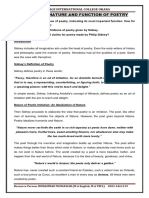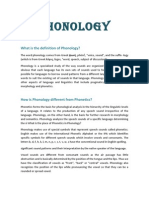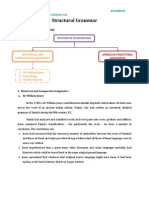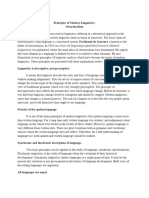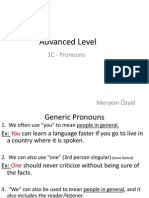Branches of Linguistics
Branches of Linguistics
Uploaded by
Muhammad MussawarCopyright:
Available Formats
Branches of Linguistics
Branches of Linguistics
Uploaded by
Muhammad MussawarOriginal Description:
Copyright
Available Formats
Share this document
Read this document in other languages
Did you find this document useful?
Is this content inappropriate?
Copyright:
Available Formats
Branches of Linguistics
Branches of Linguistics
Uploaded by
Muhammad MussawarCopyright:
Available Formats
HERITAGE INTERNATIONAL COLLEGE OKARA
BRANCHES OF LINGUISTICS
The phenomenon of language is very complex and diverse. Linguistics is a scientific and objective
field. According to Victoria A. Fromkin,
“Linguistics is the scientific study of human language and languages.”
According to Jean Aitchison:
“Linguistics tries to answer two basic questions:
what is language and how does language work.”
As it is clear from the definition, linguistics deals with language as human activity. It involves
different fields of knowledge. As it is a multi dimensional subject, it should be looked at from
different perspectives. Much research has not been done on this subject in previous centuries. In
20th and 21st centuries, latest researches have been done on this subject and the process is still
going on.
For convenience, linguistics has been divided into two categories:
1. Intra Disciplinary Areas 2. Inter Disciplinary Areas
Intra disciplinary areas are purely linguistics. Such areas have nothing to do with other subjects
or branches of knowledge. They deal only with language. Intra disciplinary areas are:
a. Theoretical/General Linguistics b. Descriptive Linguistics
c. Comparative Linguistics d. Comparative Historical Linguistics
e. Applied Linguistics
Inter disciplinary areas of linguistics mean that they have relations with other subjects or
branches of knowledge. They consider that how language interacts with the world. Inter
disciplinary areas are:
a. Sociolinguistics b. Psycholinguistics
c. Neurolinguistics d. Geographical Linguistics
e. Philosophical Linguistics
1. INTER DISCIPLINARY AREAS OF LINGUISTICS
a. Theoretical Linguistics
This branch of linguistics studies language and languages in order to construct a theory of their
structure and functions. It attempts to establish general principles for the study of all languages
Resource Person: MUHAMMAD MUSSAWAR (M.A English; M.A TEFL) 03032461219
HERITAGE INTERNATIONAL COLLEGE OKARA
and to determine the characteristics of human languages. Theoretical linguistics is divided into a
number of separate areas.
i. Phonetics ii. Phonology iii. Morphology iv. Syntax v. Semantics
b. Descriptive Linguistics
This branch of linguistics establishes facts about a particular language. In theoretical linguistics,
language is studied in general, but in descriptive linguistics language is described in particular.
Descriptive linguistics provides the data which confirms or refutes the theories put forward in
theoretical linguistics. For example, a general linguist might formulate the theory (hypothesis) that
all languages have verbs. The descriptive linguist might discard or confirm it with reference to
particular language.
c. Comparative Linguistics
It is a branch of linguistics which studies two or more languages in order to compare their
structures and to show whether they are similar or different. It is used in applied linguistics for
establishing differences between the learner’s native language and the target language in the
areas of syntax, vocabulary and sound systems.
d. Comparative Historical Linguistics
It is also called Historical linguistics/Comparative Philology/Philology. This branch of linguistics
studies the history of language change and language relationships. By comparing earlier and later
forms of a language and by comparing different languages, it has been possible to show that
certain languages are related e.g. Greek, Latin, English and French. There are two methods of the
historical study of a language.
A. Diachronic (Historical) B. Synchronic (Non Historical)
Diachronic linguistics means to study the history of language thoroughly from A to Z.
Synchronic linguistics means to study the history of language at some particular time.
d. Applied Linguistics
It is the study of second and foreign language learning and teaching. It also deals with the study of
language in relation to practical problems, such as translation, vocabulary, and grammar. Applied
linguistics develops its own theoretical models of language and uses them in practical areas.
Resource Person: MUHAMMAD MUSSAWAR (M.A English; M.A TEFL) 03032461219
HERITAGE INTERNATIONAL COLLEGE OKARA
2. INTER DISCIPLINARY AREAS OF LINGUISTICS
a. Sociolinguistics
Sociolinguistics studies language in relation to society. It studies all the aspects of relationship
between language and society. It tells us about the impact of language on society and impact of
society on language. It includes bilingualism, multilingualism and standard and non standard forms
of language.
b. Psycholinguistics
Psycholinguistics studies language in relation to psychology. It deals with language and the mind
of an individual. It includes the areas like language acquisition of L1 and L2, behaviourism, and
mentalism.
c. Neurolinguistics
It studies the psychological basis of language and language disorder. It has a deep relationship
with Clinical linguistics.
d. Geographical Linguistics
This branch of linguistics studies language in relation to geography. It describes the variation in
language with reference to the geographical changes.
e. Philosophical Linguistics
It studies the relation of language with philosophy.
f. Anthropological Linguistics
This branch of linguistics studies the relationship between language and culture in a community,
e.g. its traditions, beliefs, and family structure.
All these branches of language are equally important because they bring to light the different
aspects of language so that we can understand language comprehensively. Without the study of
these branches, it is impossible for us to have the first hand information about the ins and outs of
language.
Resource Person: MUHAMMAD MUSSAWAR (M.A English; M.A TEFL) 03032461219
You might also like
- Hatch Battery Market Solutions-BrochureDocument16 pagesHatch Battery Market Solutions-BrochurexianghuaokNo ratings yet
- Linguistics Past PapersDocument3 pagesLinguistics Past PapersSaba Malik90% (10)
- Philip Sidney NATURE AND FUNCTION OF POETRYDocument3 pagesPhilip Sidney NATURE AND FUNCTION OF POETRYMuhammad Mussawar83% (12)
- Difference Between Phonetics and PhonologyDocument2 pagesDifference Between Phonetics and PhonologyMandyMacdonaldMominNo ratings yet
- BOL IN Earth & Life ScienceDocument8 pagesBOL IN Earth & Life ScienceJeyn T. Redoña IINo ratings yet
- Unit 1 Introduction To LinguisticsDocument6 pagesUnit 1 Introduction To LinguisticsRamanakumar Mohan100% (2)
- Phonetics & Phonology and Other DisciplinesDocument6 pagesPhonetics & Phonology and Other Disciplinesanmar ahmed100% (2)
- Final Exam in SociolinguisticsDocument7 pagesFinal Exam in SociolinguisticsCharissa Eniva Calinggangan100% (1)
- What Is Syntax?Document25 pagesWhat Is Syntax?Aqlili Matra100% (2)
- Phonology PDFDocument23 pagesPhonology PDFlg_2012_udegyerodriguezestrada100% (5)
- Chapter 20 - Language and Culture Flashcards - QuizletDocument2 pagesChapter 20 - Language and Culture Flashcards - QuizletHussain K .Neama100% (2)
- Sociolinguistics Exam Questions BDocument2 pagesSociolinguistics Exam Questions Bazizkhessibi100% (3)
- Expert Mode Organizational Units/Objects Transaction CodesDocument51 pagesExpert Mode Organizational Units/Objects Transaction CodesPradeep Kumar100% (1)
- Linguistics and Its BranchesDocument12 pagesLinguistics and Its BranchesGulfam Riaz100% (2)
- Seven Types of MeaningDocument10 pagesSeven Types of MeaningSohel BangiNo ratings yet
- Linguistics Question AnswerDocument8 pagesLinguistics Question AnswerAnonymous v5QjDW2eHxNo ratings yet
- Branches of LinguisticsDocument18 pagesBranches of LinguisticsRauha Salaam100% (3)
- Linguistic Theories, Branches and FieldsDocument13 pagesLinguistic Theories, Branches and FieldsChaima Guezzzi100% (2)
- Language Maintenance and Language ShiftDocument19 pagesLanguage Maintenance and Language ShiftYANGUAS, NIÑA MICAELLA R.No ratings yet
- Structural GrammarDocument7 pagesStructural GrammarNurfaizah Akidah100% (8)
- Semantics PPT 2018 PDFDocument179 pagesSemantics PPT 2018 PDFTri T100% (1)
- The Scope of Psycholinguistics Studies and The SigDocument9 pagesThe Scope of Psycholinguistics Studies and The SigAdhi Jaya Chucha ChoChesNo ratings yet
- Intro 2 LinguisticsDocument217 pagesIntro 2 LinguisticsHelena LópezNo ratings yet
- Article Morphology of English Vs UrduDocument16 pagesArticle Morphology of English Vs UrduMuhammad Athar KhurshidNo ratings yet
- Grimms LawDocument3 pagesGrimms LawAimee ThomasNo ratings yet
- Morphological SystemsDocument12 pagesMorphological SystemsShafiq Khan100% (1)
- Past Paper of Linguistic 2004 To 2019Document13 pagesPast Paper of Linguistic 2004 To 2019Noor UlainNo ratings yet
- Morphological TreesDocument10 pagesMorphological TreesAnđaNo ratings yet
- Assignment - 1 SociolinguisticsDocument6 pagesAssignment - 1 SociolinguisticsSyed Asim Raza75% (8)
- Stylistics As A Branch of LinguisticsDocument34 pagesStylistics As A Branch of Linguisticswamanse199283% (6)
- 5 - Traditional Grammar and Modern LinguisticsDocument16 pages5 - Traditional Grammar and Modern Linguisticsbengrad nabil100% (1)
- Phonological RulesDocument5 pagesPhonological RulesJasmin Cadir100% (1)
- Branches of LinguisticsDocument14 pagesBranches of LinguisticsDo Miranda100% (4)
- Schools of LinguisticDocument25 pagesSchools of LinguisticMoli Moli88% (8)
- Linguistic ConflictsDocument26 pagesLinguistic Conflictsوشال VISHAL67% (3)
- Stylistics and Stylistic VariationDocument3 pagesStylistics and Stylistic VariationBS ENGLISH100% (1)
- StylisticsDocument4 pagesStylisticsWahid ShantoNo ratings yet
- Synchronic Diachronic LinguisticsDocument7 pagesSynchronic Diachronic LinguisticsZara Nur50% (2)
- @morphology Spot QuestionsDocument9 pages@morphology Spot QuestionsImelda Tiong100% (2)
- MCQs-Phonetics and PhonologyDocument5 pagesMCQs-Phonetics and PhonologyAnonymous lUfprN1U62% (26)
- Lexical Level of Stylistic AnalysisDocument24 pagesLexical Level of Stylistic AnalysisRJEREENo ratings yet
- Morphology NOTESDocument13 pagesMorphology NOTESAshfaq AslamNo ratings yet
- English SemanticsDocument14 pagesEnglish SemanticsGoran TomacNo ratings yet
- X Bar TheoryDocument3 pagesX Bar Theoryvanilla_42kp100% (2)
- Relationship Between Language and SocietDocument3 pagesRelationship Between Language and SocietACADEMIC TOOLS100% (3)
- Chapter 19 - Language and Social VariationDocument10 pagesChapter 19 - Language and Social VariationHussain K .Neama100% (3)
- Historical Development of StylisticsDocument13 pagesHistorical Development of StylisticsBocoumNo ratings yet
- Applied Linguistics - Docx-Short Questions and AnswersDocument16 pagesApplied Linguistics - Docx-Short Questions and AnswersSaneka Setram89% (9)
- Generative LinguisticsDocument43 pagesGenerative Linguisticssarah100% (1)
- MIDTERM EXAM-linguisticsDocument3 pagesMIDTERM EXAM-linguisticsPepitoNo ratings yet
- Feminist Stylistics:: Historical PerspectiveDocument2 pagesFeminist Stylistics:: Historical PerspectiveAaqib HarganNo ratings yet
- Principles of Modern LinguisticsDocument3 pagesPrinciples of Modern Linguisticsria100% (1)
- Introduction To LinguisticsDocument30 pagesIntroduction To LinguisticsNatalia KaczmarczykNo ratings yet
- Introduction To StylisticsDocument23 pagesIntroduction To StylisticsGenevieveA.Poso0% (1)
- L 9 Historicism and StructuralismDocument16 pagesL 9 Historicism and StructuralismMeme LashNo ratings yet
- Universal Grammar TheoryDocument6 pagesUniversal Grammar Theoryapi-225325678100% (1)
- Applied Linguistics - SummaryDocument7 pagesApplied Linguistics - SummaryTharanga Hewage90% (10)
- Linguistics l45Document92 pagesLinguistics l45Elaaf MuhammadNo ratings yet
- Sense RelationsDocument8 pagesSense RelationssharpNo ratings yet
- ENG502Grand Quiz PreparationsDocument17 pagesENG502Grand Quiz PreparationsReddit and TwitterNo ratings yet
- Lte 101Document6 pagesLte 101Kih LinNo ratings yet
- Introduction To Lingusti1Document9 pagesIntroduction To Lingusti1titinalansariNo ratings yet
- A Course in Applied Linguistics For Master Two Students of EnglishDocument112 pagesA Course in Applied Linguistics For Master Two Students of EnglishBachir Hocine100% (1)
- M O D U L E 2 - Applied LinguisticsDocument11 pagesM O D U L E 2 - Applied LinguisticsShean Jerica Salem100% (1)
- Poem Analyis TemplateDocument3 pagesPoem Analyis TemplateMuhammad MussawarNo ratings yet
- MDC T Prep R Tion Guide: Best Books To Re DDocument2 pagesMDC T Prep R Tion Guide: Best Books To Re DMuhammad MussawarNo ratings yet
- The Last Question SummaryDocument2 pagesThe Last Question SummaryMuhammad MussawarNo ratings yet
- Logical Basis of Hypothesis Testing in Scientific Research: A Logic Primer To Accompany Giere 1984, Chapter 6Document4 pagesLogical Basis of Hypothesis Testing in Scientific Research: A Logic Primer To Accompany Giere 1984, Chapter 6Muhammad MussawarNo ratings yet
- Theme The Last QuestionDocument2 pagesTheme The Last QuestionMuhammad MussawarNo ratings yet
- ہئیت پسندیDocument14 pagesہئیت پسندیMuhammad MussawarNo ratings yet
- Conversion FormulaDocument1 pageConversion FormulaMuhammad MussawarNo ratings yet
- Wordsworth Theory of Poetic Diction & Poets PoetryDocument4 pagesWordsworth Theory of Poetic Diction & Poets PoetryMuhammad Mussawar100% (7)
- Asghar Hameed FarahaniDocument16 pagesAsghar Hameed FarahaniMuhammad MussawarNo ratings yet
- Philip Sidney Epitome of Renaissance CriticismDocument2 pagesPhilip Sidney Epitome of Renaissance CriticismMuhammad Mussawar60% (5)
- Unige 11985 Attachment01Document25 pagesUnige 11985 Attachment01gem68megNo ratings yet
- Character Skecth of GertrudeDocument1 pageCharacter Skecth of GertrudeMuhammad MussawarNo ratings yet
- Sidney Replies On ObjectionsDocument3 pagesSidney Replies On ObjectionsMuhammad Mussawar0% (1)
- Bibliography Writing: Apa & Mla: Referencing StylesDocument2 pagesBibliography Writing: Apa & Mla: Referencing StylesMuhammad MussawarNo ratings yet
- Philip Sidney Comedy & Tragedy in English TheatreDocument3 pagesPhilip Sidney Comedy & Tragedy in English TheatreMuhammad Mussawar67% (9)
- MCS GCUF NotesDocument17 pagesMCS GCUF NotesMuhammad MussawarNo ratings yet
- The Epic and The TragedyDocument2 pagesThe Epic and The TragedyMuhammad Mussawar100% (1)
- The Rise of English Novel in 18th CenturyDocument1 pageThe Rise of English Novel in 18th CenturyMuhammad MussawarNo ratings yet
- My School Lesson PlanDocument4 pagesMy School Lesson PlanMuhammad MussawarNo ratings yet
- Public Rbs 6201 GSM Commissioning - CreatDocument29 pagesPublic Rbs 6201 GSM Commissioning - CreatminhNo ratings yet
- Hacer MapasDocument29 pagesHacer MapaspafrikiyoNo ratings yet
- Types of Nuclear ReactorsDocument19 pagesTypes of Nuclear ReactorsUgur GuvenNo ratings yet
- 1055 OperacionDocument220 pages1055 Operacionreidco tallerkm16No ratings yet
- Hqplayer™ Desktop: User ManualDocument50 pagesHqplayer™ Desktop: User ManualuqmhrdNo ratings yet
- Base Area Integers 1Document2 pagesBase Area Integers 1Meaza BeleteNo ratings yet
- Manual Jump Starter DC Power SourceDocument25 pagesManual Jump Starter DC Power SourceJorge Duran FidilioNo ratings yet
- Limitless Learning AssessingDocument23 pagesLimitless Learning AssessingSushan MaharjanNo ratings yet
- Introductory Handbook On CBTCDocument88 pagesIntroductory Handbook On CBTCBibek SinghNo ratings yet
- Book Share Proof of Disability FormDocument2 pagesBook Share Proof of Disability FormSojib SajidNo ratings yet
- Maternal and Child Nursing - Antepartum Practice Test With AnswersDocument6 pagesMaternal and Child Nursing - Antepartum Practice Test With Answersgelean payodNo ratings yet
- Advanced Level 1C Pronouns PresentationDocument8 pagesAdvanced Level 1C Pronouns PresentationniyazikorelNo ratings yet
- OpmanDocument9 pagesOpman키지아No ratings yet
- Clarion: A Global Brand That Puts Your Future First: Catalogue For Car Audio, Multimedia and NavigationDocument4 pagesClarion: A Global Brand That Puts Your Future First: Catalogue For Car Audio, Multimedia and Navigationin kNo ratings yet
- Apache Egypt 2008 EIA Pre-Seismic and Drilling ActivitiesDocument182 pagesApache Egypt 2008 EIA Pre-Seismic and Drilling ActivitiesКоля БігунNo ratings yet
- Donner 39 Inch Electric Guitar Beginner Kit Red Full-Size Starter Package HSS Pick Up With All Accessories Amp Online Lesson BagDocument1 pageDonner 39 Inch Electric Guitar Beginner Kit Red Full-Size Starter Package HSS Pick Up With All Accessories Amp Online Lesson BagКсения АнтонюкNo ratings yet
- 08 Procedure For Design and Development Preview enDocument4 pages08 Procedure For Design and Development Preview enHadj Ali BoumedieneNo ratings yet
- Good Governance Handbook - HQIPDocument17 pagesGood Governance Handbook - HQIPAnggika Yelzi PratiwiNo ratings yet
- Drug StudyDocument41 pagesDrug StudyCatherine PradoNo ratings yet
- Amiri Barak - Works CitedDocument1 pageAmiri Barak - Works Citednae0225No ratings yet
- Hydraulics AssignmentDocument24 pagesHydraulics AssignmentHaseeb JamalNo ratings yet
- Silo - Tips Oracle 11g r2 Grid Infrastructure Installation On 2 Node Cluster Using VirtualboxDocument29 pagesSilo - Tips Oracle 11g r2 Grid Infrastructure Installation On 2 Node Cluster Using VirtualboxTAHA KANNANENo ratings yet
- Ce656 1Document188 pagesCe656 1Abhishek VobbareddyNo ratings yet
- Quantative Aptitude All Type Question and AnswersDocument77 pagesQuantative Aptitude All Type Question and AnswersPrasanta NaskarNo ratings yet
- CIS RAM Workbook Version CCDocument551 pagesCIS RAM Workbook Version CCIgnacio LanserosNo ratings yet
- Foreign Exchange Management Act, 2000: Presented By: Akanksha MalhotraDocument19 pagesForeign Exchange Management Act, 2000: Presented By: Akanksha MalhotraGaurav KumarNo ratings yet
- A/T/N: An Unbiased Descriptive Classification Scheme For Alzheimer Disease BiomarkersDocument11 pagesA/T/N: An Unbiased Descriptive Classification Scheme For Alzheimer Disease BiomarkersSatya YudhayanaNo ratings yet


